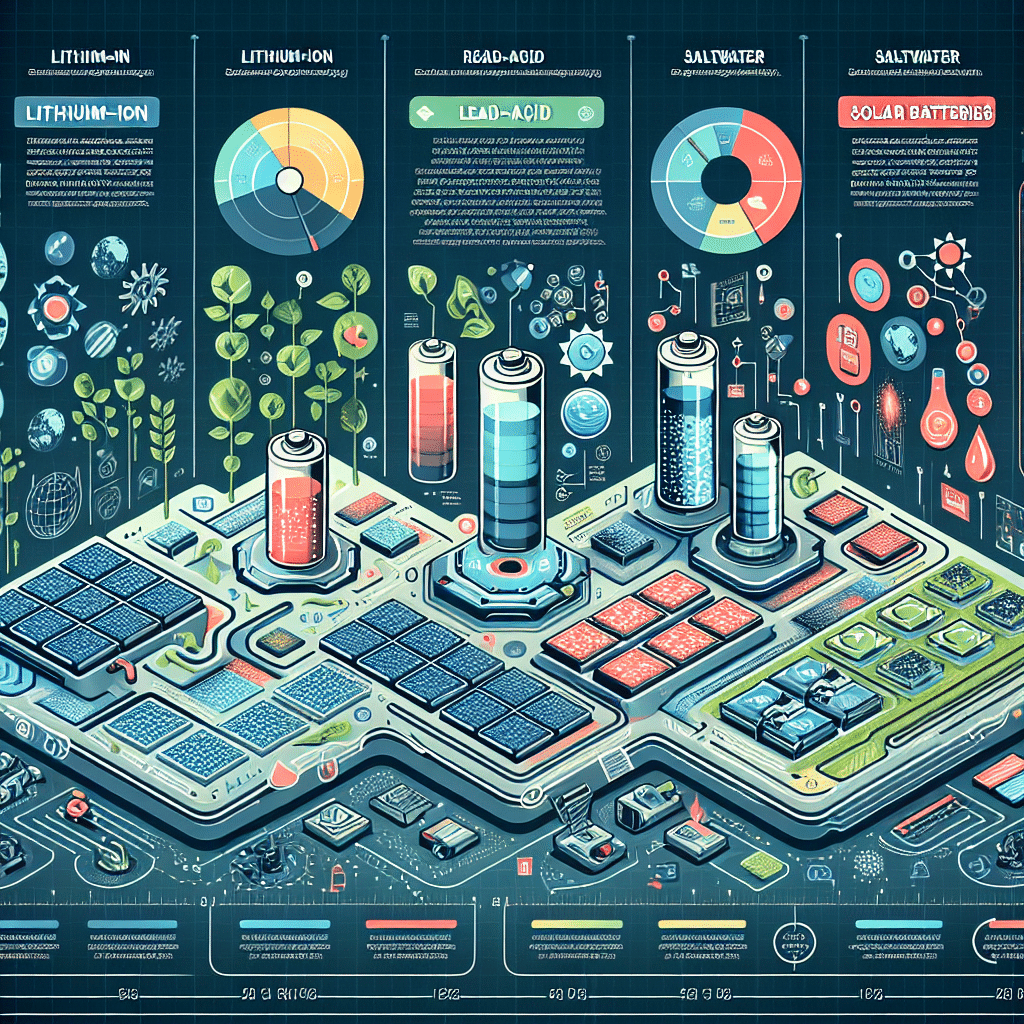Understanding Solar Batteries: An Essential Guide for 2025
What is a Solar Battery?
A solar battery stores energy generated by solar panels for later use. It allows homeowners and businesses to utilize solar power even when sunlight isn’t available, such as during the night or on cloudy days. As the demand for renewable energy surges, understanding solar batteries becomes crucial for optimizing energy consumption and reducing reliance on the grid.
Types of Solar Batteries
-
Lithium-Ion Batteries
- Overview: Lithium-ion batteries are the most popular choice for solar storage due to their high energy density and efficiency.
- Pros: High depth of discharge (DoD) allows for more usable energy; robust performance in varying temperatures.
- Cons: Higher initial costs compared to other types; potential lifespan of 5-15 years depending on usage and conditions.
-
Lead-Acid Batteries
- Overview: The traditional option for solar storage; they are further divided into flooded and sealed (AGM or Gel).
- Pros: Lower initial cost; proven reliability over decades.
- Cons: Shorter lifespan (3-5 years for flooded; 5-10 years for sealed); lower DoD means less usable energy.
-
Flow Batteries
- Overview: Flow batteries store energy in liquid electrolytes, making them suitable for larger-scale applications.
- Pros: Long cycle life; easy scalability; reduced risk of overheating.
- Cons: Higher cost and larger physical footprint; not yet widely available for residential use.
-
Saltwater Batteries
- Overview: An emerging technology that utilizes sodium and water, making them safer and more eco-friendly.
- Pros: Non-toxic materials; longer cycle life and low maintenance.
- Cons: Lower energy density compared to lithium-ion; higher costs than traditional lead-acid technologies.
Key Factors to Consider When Comparing Solar Batteries
-
Capacity
- Measured in kilowatt-hours (kWh), capacity indicates how much energy a battery can store and provide. Understanding your energy needs (daily consumption, peak load times) helps in selecting the right capacity.
-
Depth of Discharge (DoD)
- DoD refers to the percentage of the battery that can be used. A higher DoD means you can utilize a larger portion of the battery’s capacity without degrading its lifespan.
-
Round-trip Efficiency
- This metric indicates how much energy can be used versus how much is lost during charging and discharging. Lithium-ion batteries typically exhibit higher round-trip efficiency (around 90-95%).
-
Lifespan and Warranty
- Consider the battery’s cycle life, which indicates how many charge and discharge cycles it can undergo before performance declines. Warranties vary greatly, so opt for long-term coverage (at least 10 years).
-
Installation and Maintenance Costs
- Factor in the total cost, including installation. Lithium-ion systems may require specialized installation, but they often need less maintenance than lead-acid systems.
-
Scalability
- The ability to expand or reduce your battery system is critical, especially for growing energy needs. Some systems might allow for expansion with additional batteries.
Top Solar Batteries of 2025
-
Tesla Powerwall 2
- Capacity: 13.5 kWh
- DoD: 100%
- Lifespan: 10 years
- Round-trip Efficiency: ~90%
- Features: Integrates seamlessly with solar systems; enables energy management via an app.
-
LG Chem RESU 10H
- Capacity: 9.8 kWh
- DoD: 95%
- Lifespan: 10 years
- Round-trip Efficiency: 90%
- Features: Compact size for easier installation; suitable for both on-grid and off-grid applications.
-
Sonnen Eco 10
- Capacity: 10 kWh
- DoD: 100%
- Lifespan: 10,000 cycles or approximately 10 years
- Round-trip Efficiency: 90%
- Features: Modular design; home energy management system included.
-
Enphase Encharge 10
- Capacity: 10 kWh
- DoD: 100%
- Lifespan: 6,000 cycles (average)
- Round-trip Efficiency: ~96%
- Features: Integrated with Enphase microinverters for a streamlined system.
-
BYD Battery-Box Premium HVS
- Capacity: Up to 20 kWh (scalable)
- DoD: 95%
- Lifespan: 6000 cycles
- Round-trip Efficiency: 90%
- Features: Modular design allows for tailored energy solutions; compatible with many inverters.
Solar Batteries for Off-Grid vs. Grid-Tied Systems
-
Off-Grid Systems: Require robust storage options to provide energy continuously. Larger capacity batteries with high DoD are typically favored to handle varying weather patterns and energy demands.
-
Grid-Tied Systems: These systems can sell excess energy back to the grid, meaning a smaller battery may suffice, as grid electricity can supplement solar output during less sunny periods.
Future Trends in Solar Battery Technology
-
Sustainability Enhancements
- The push for eco-friendly materials will shape future developments, focusing on battery recycling and using biodegradable components.
-
Cost Reductions
- Continued advancements in manufacturing processes are expected to decrease costs for lithium-ion and emerging technologies, making solar energy more accessible.
-
Integration with Smart Home Technologies
- As smart energy management systems evolve, batteries will increasingly integrate with home automation, optimizing energy use in real time.
-
Vertical Farming and Renewable Integration
- Innovations may lead to integration between solar batteries and agricultural practices, improving energy efficiency in farming operations.
Final Considerations
Selecting the right solar battery for 2025 requires careful analysis of your unique energy needs and future energy goals. By exploring various options regarding technology, capacity, and features, you can make informed decisions that not only enhance sustainability but also positively impact your financial outlook in the long run. Prioritize ongoing research and updates in this space, as the renewable energy landscape is rapidly evolving with technological advancements and regulatory changes that could influence your choices.
